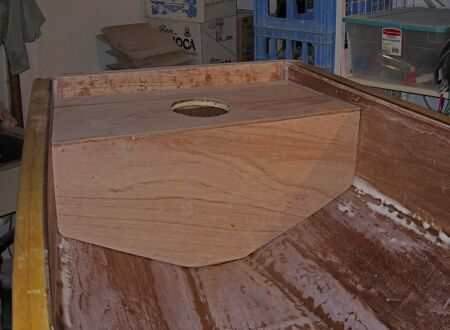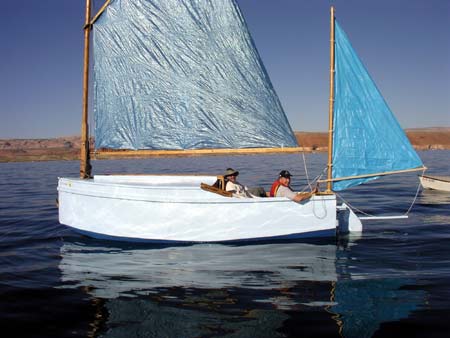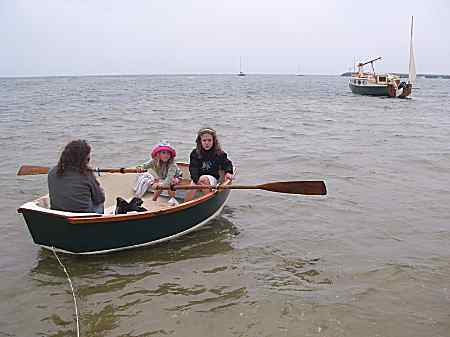
Dave Blowers sent this photo of his Toto in the Phillipines.
Contents:
Contact info:
Jim Michalak
118 E Randall,
Lebanon, IL 62254Send $1 for info on 20 boats.
Jim Michalak's Boat Designs
118 E Randall, Lebanon, IL 62254
A page of boat designs and essays.
(1apr08)This issue will show a fin propulsion system in a Roar2. The 15 April issue will present how to rig a sprit sail.
MESSABOUT NOTICE:
THE REND LAKE MESSABOUT WILL TAKE PLACE ON JUNE 6 and 7 AT THE GUN CREEK RECREATION AREA AT REND LAKE IN SOUTHERN ILLINOIS. MORE DETAILS WILL FOLLOW BUT IT MIGHT BE PRUDENT TO MAKE CAMPING RESERVATIONS IF YOU INTEND TO ATTEND.THE BOOK IS OUT!
BOATBUILDING FOR BEGINNERS (AND BEYOND)
is out now, written by me and edited by Garth Battista of Breakaway Books. You might find it at your bookstore. If not check it out at the....ON LINE CATALOG OF MY PLANS...
...which can now be found at Duckworks Magazine. You order with a shopping cart set up and pay with credit cards or by Paypal. Then Duckworks sends me an email about the order and then I send the plans right from me to you.

|
Left:
Dave Blowers sent this photo of his Toto in the Phillipines.
|
|
|
Flipper Powered Roar2
I GOT THIS LETTER WITH PHOTOS....
...from Doug Roney in Alberta. As you will see he fitted a Hobie flipper drive to his Roar2. I will present his letter and comment a bit at the end.
"HI JIM,
I have enclosed a CD with a number of photos of Roar2 that I have on the water with a pedal drive system. I had a great summer with it and got it into both the Atlantic and Pacific Oceans and it performed well. The ultimate compliment came from an old fellow who had worked for 35 years in a shipyard in Halifax, Nova Scotia. He looked the boat over while it was loaded on the truck and said, "Nice Hull".
I have named it WABI SABI which is a Japanese expression which, roughly translated, means Nothing is ever perfect, Nothing is ever finished and Nothing lasts forever.
An explanation for the photos:

Wabi 1a The finished product in a time trial using a GPS unit to measure top speed. For short bursts I can get 6mph but wouldn't maintain that for very long.

Wabi 1a1 Photo of a friend showing a better view of the pedal position.
I have included photos of how I modified things to make it pedal powered. I didn't want any thwarts since I needed to sit forward to pedal and backward to row. To compensate I put flotation tanks at each end and glassed the gunnels which made it much more rigid.

Wabi 1c Shows blocking added so I could add rudder and flotation tank on rear. Wood is in place and ready to be glassed in and port added.

Wabi 1e Shows preparation of front flotation tank.

Wabi 1g shows hole cut in bottom of boat for drive mechanism.

Wabi 1h shows side view of the box that mounts the drive and forms the base of the well.

Wabi 1j shows the rudder. Iron flat bar glassed into it so it is weighted.

Wabi 1k Pully mechanism to move the rudder.

Wabi 1l Steering mechanism to control the rudder. Flat iron bar glassed to side and magnets installed in wooden block. Slide forward and back to move rudder and magnet will hold it in place.

Wabi 1m This is the Hobi Mirage drive side view. Pedaling action moves flippers from side to side. Front on flipper is on a rigid rod while rear is flexible and bends to create a push forward as the flipper is moved from side to side.

Well for the drive with locking mechanism in place.

Wabi 1o Pedal drive seated in well.

Wabi1p Drive flippers through bottom of boat.

Wabi1q Seat and back support. The support is also from Hobi and is the backrest for their pedal powered kayak.

Front T of rack to carry boat on top of truck. Nose is stapped in place and then T swivels. Boat swung around and set onto rear rack. I designed and built the rack so I can still tow my fifth wheel trailer with the boat in front. Carried this way for eleven thousand miles this summer.
Regards, Doug Roney"
THANKS DOUG!!
NOW SOME COMMENTS...
I Googled around for the Mirage drive and it looks to cost about $500 basic with options on top. Not cheap. The top speed he noted of 6mph is about what you can pull with oars for a very short while. The Mirage flipper drive is not meant for really thin waters, needs a lot more draft than oars, which essentially don't need any. Also the oar drive needs no rudder. (HEY! Isn't that magnet rudder hold system simple and cool!) The flipper drive well must be open on top and fairly shallow. Doug said his was 6" deep and making it deeper would result in awkward seating. So the well might be a bit of a liability in rough water although I asked Doug about that and he said it was not an issue in his summer's use. I take it the flipper boat is solo only although Doug has his set up to row also and can be used to row two. I assume the flipper drive is forward only, no backing allowed. BUT, sitting forward has always been the dream of rowers and many much more complex systems have been invented to allow forward facing rowing. Finally the flipper system is essentially hands free - if you are a fisherman you have to have it. I thought Hobie's ads really pushed the fishing idea over touring.
Anyway, it is a cool setup and I thought you would enjoy seeing it.
FROLIC2

FROLIC2, CUDDY MULTI SKIFF, 20' X 5', 400 POUNDS EMPTY
The photos show the prototype Frolic2 built by Larry Martin of Coos Bay, Oregon. Larry built the boat quite quickly this past winter including sewing the sail to the instructions given in the plans. He reported sailing it for the first time on a ripping day with an occasional 2' wave. I always advise testing a new boat in mild weather, especially a new design, but Larry got away with it. Looking at his photos, the neat work, and simple efficient rigging suggests to me that Larry has been sailing small boats a long time.

Frolic2 has a small cabin, probably only for one to sleep in because the multichines that make the boat good in rough water also rob you of floor space. To say it another way, the nice big floor space of a flat bottomed sharpie is what pounds in rough water and makes you uncomfortable. But Frolic2 has a 6' long cockpit so someone could sleep there too. There is bench seating. The cabin top has a slot top down the center and you can stroll right through the cabin standing upright in good weather and out the front bulkhead to the beach. The mast is offset to one side so you will need not have to step around it. Phil Bolger showed us how to do this about 15 years ago and it works. But Larry went conventional with his boat, mounting the mast on centerline and decking in the front of the cabin. On a slot top cabin you use a simple snap on tarp to cover the slot in rain or cold or bugs.

Frolic2 was designed for rough water, long and lean, especially in the bow, and with multiple chines. She's really a takeoff of my Toto canoe in shape. Larry omitted the motor well you see in the lines, and the oarlocks too (The wind must blow just right all the time in Oregon?) but I intended this to be a multi skiff sort of boat with rowing and motoring abilities. You can't row a boat of this size in any wind or waves but in a calm you can travel far if you have patience. I didn't fool around with a gadget motor mount - I put the motor well right in the middle and offset the rudder instead of the other way around. This worked out very well on the high powered Petesboat. We'll see how it goes on a narrow boat because the second prototype is getting the blueprint well as you see in the photo below of the Colorado Frolic2 still being built. You need little power on a boat like this, 2 or 3 hp is more than enough.
The lug rig is for quick easy stowing, rowing, and towing. (The blueprint sail is actually the same size and shape as that of a Bolger Windsprint, a boat which weighs maybe a third as much as Frolic2 and is much narrower. But I think the Windsprint might be over sparred for its size and weight.) Larry reports the rig is about right for the boat, sailing fine with a reef in and three adults on a windy day. The lug sail can be closer winded reefed than when full, perhaps because the sail is then shorter and the yard better controlled (less sail twist). For that matter a sharpie sprit sail the same size as the lug might be smarter in rough water conditions if you can live with the long mast. Switching rigs won't be hard. The mast can be relocated almost anywhere in the slot top without altering the hull to any degree. You just need extra partner and step fittings.


Update, 2006. Jeff Blunk's Colorado Frolic2 eventually found its way to Illinois and then to our Rend Lake Messabout in the hands of Richard Harris. We had a chance to try it out and I was quite pleased. It was fast and powerful. At one point with three men on board, with Max at the tiller, I went forward to tweak the sail which took a couple of minutes with me staring up at the sail. That done I looked back and saw that we were really rolling along.

And Gary Blankenship's Frolic2 completed the Everglades 300 mile challange with him reporting sailing for hours at 7 knots or more. Last count he completed three of the challenges with a 4th overall in 2007. Here is Gary's Frolic2:

Construction is with taped seams from eleven sheets of 1/4" plywood and two sheets of 1/2" plywood.
Plans for Frolic2 are $35.
Prototype News
Some of you may know that in addition to the one buck catalog which now contains 20 "done" boats, I offer another catalog of 20 unbuilt prototypes. The buck catalog has on its last page a list and brief description of the boats currently in the Catalog of Prototypes. That catalog also contains some articles that I wrote for Messing About In Boats and Boatbuilder magazines. The Catalog of Prototypes costs $3. The both together amount to 50 pages for $4, an offer you may have seen in Woodenboat ads. Payment must be in US funds. The banks here won't accept anything else. (I've got a little stash of foreign currency that I can admire but not spend.) I'm way too small for credit cards.
I think David Hahn's Out West Picara is the winner of the Picara race. Shown here on its first sail except there was no wind. Hopefully more later. (Not sure if a polytarp sail is suitable for a boat this heavy.

Here is a Musicbox2 I heard about through the grapevine.

This is Ted Arkey's Jukebox2 down in Sydney. Has a temporary rig and he is working on the blueprint rig.

And the Vole in New York is Garth Batista's of www.breakawaybooks.com, printer of my book and Max's book and many other fine sports books. Boat is done, shown here off Cape Cod with mothership Cormorant in background, Garth's girls are one year older. Beautiful job! I think Garth is using a small lug rig for sail, not the sharpie sprit sail shown on the plans, so I will continue to carry the design as a prototype boat.

And the Leinweber's make another prototype! This one by Sandra, an Imresboat shown here on its first outing. They are taking it on a "cruise" so more about it later.

The Mikesboat project has about all its major elements falling into place. He is working outside...

And a new Down Under Blobster, right side up....

AN INDEX OF PAST ISSUES
Hullforms Download (archived copy)
Plyboats Demo Download (archived copy)
Brokeboats (archived copy)
Brian builds Roar2 (archived copy)
Herb builds AF3 (archived copy)
Herb builds RB42 (archived copy)